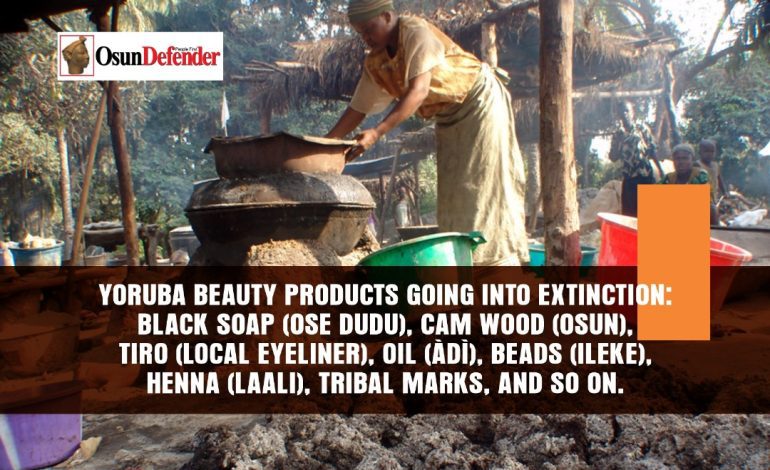Yoruba Beauty Products Going Into Extinction


The Yoruba culture is a repository of various art forms – ornamental designs, architecture, carvings, costumes, beautification and styles. Distinct amongst this is the art of beautification. The Yoruba people are fashion conscious and have distinctive ways of self-fashioning; displayed in hairstyles, dressing and body decorations, paintings, etc. Body adornment is a rich and vast culture among the Yoruba people especially the women. Over the years, the Yoruba women make use of varieties of traditionally made products, such as oils, soaps, fragrances, and beads to enhance body beauty.
Body beautification art in Yoruba culture involve the use of decorative markings in the form of tattoos, face and body scarification on the human body as a way to express an individual’s status, spiritual beliefs, or ethnic affiliation. These body art convey complex messages about identity and social status. Permanent body markings emphasize fixed social, political and religious roles. Facial scarification in Yoruba is used for identification of ethnic groups, families, individuals, but also to express personal beauty.
It is also performed on girls to mark stages of the life process, such as puberty, marriage etc. They can assist in making them more attractive to men, as the scars are regarded as appealing to touch as well as to look at, but also as testimony that women will be able to withstand the pain of childbirth with raised scars. And the best part is these traditional products were cheap and readily available. However, in the wake of civilisation, this rich cultural heritage employed by Yoruba women to enhance their beauty is however fading away as a result of erosion of cultural values brought about by the effect of Western culture and education. Below are some the local products used to by Yoruba women to enhance their beauty:
The Black Soap (Ose Dudu)


The Yoruba word “ose dudu” literally translate to the black soap.This is because the common color of the soap is black. The black soap, however, varies in color from black to grayish-white depending on the materials used in the production.The soap is made from palm kernel after the palm oil has been extracted. Alternatively, cocoa pods may be used. The pods are also dried, roasted and cooked. The soap obtained from cocoa pods is grayish in colour and mixed with the black soap is used for washing babies and used as facial scrubs.Some oils are then applied to the skin including the scalp after a bath.
Osun (Cam Wood)


There are two products referred to as Osun. One is made from the leaves of Pterocarpus Osun. The leaves are plucked, dried, and pounded, and change to a reddish color. The other product is made from “ okuta osun” stones which yield a reddish powder when rubbed against hard surfaces. When applied to the skin, the rough texture of the ground cam wood possibly causes epidermabrasion which results in the removal of dead skin tissue, encouraging new cell production, as well as opening up blocked follicles.
Oils


The common oil used among the Yoruba for adornment include Àdí ẹ̀yan, Àdí Àgbọn, and Òrí. Àdí Ẹ̀yan is made from palm kernel while Àdí Àgbọn is made from coconut. Ori is made from the fruit of the Shea butter tree. These oils have natural soothing effects on skin often used as base ingredients for many artificial oils used in cosmetics production today.
Tìírò (Local Eyeliner)


Tìírò is antimony, which when ground with a piece of charcoal, can be applied to the eyelashes. The powdered form is neatly packed into conical metal pot or dispenser and applied to the lower rim of the eye with a round ended stick for facial beautification. A small rod in the container allows the application to the margins of the eyelids. Tìírò has been applied for its beautifying and attractive effect on the eyes. It is also used for its protective or sunlight shielding effect on the eyes as well as in the treatment of ophthalmologic infections to cleanse the eyes.
Ẹfun


This is a white powder-like substance obtained from the pounding of the dried fruit of some trees in the locality. Efun and osun are often applied to babies to cure nappy rashes and beautify their body
Beads (Iyun-ileke)


Beads are ornaments worn for both males and females in Yoruba culture. worn around the waist and around the neck and wrists. Virtually, the waist of every Yoruba females are adorned with beads. They served two functions – to assess waistline growth and for aesthetic value. The beads were worn by both genders. Traditional chiefs of both genders wore beads on both the neck and the wrists. Younger females wore beads in these two anatomic regions, as well as on the waist, during festivals and some traditional rites/initiations . The status of the individual in the past was assessed by the types, sizes, and quality of the beads.They feature who have been made traditional chiefs
Henna (Laali)


Amongst the Yoruba, henna popularly known as Laali is used for coloring of the nails, palms and toes. Its use in the southwestern region of Nigeria is, however, much less than in the far north, amongst the Hausa, Fulani, and Nupe. It imparts a reddish-brown color to the skin/nail plates. It is used to draw decorative designs on fingers and thighs.
Tribal Marks/ Tattoos


Since ancient times, many African tribes have been recognized by the marks on their skin. Tribal marks are usually inscribed on the faces at tender ages. The procedure involved burning of candle or cutting the skin similar to that used for circumcision. After the normal procedure is done by the surgeon, medication is then applied to the incision followed by a native dye.
After 2 days, palm oil is applied with the aid of a feather. The patient either does not bathe or the affected part is kept dry. Also, decorative markings in the form of tattoos known as “Ara fínfín/ Ara sísọ” are common amongst the Yoruba. The abdomen and arms are common sites for these decorative markings. Unlike in other racial groups, black is the only color adopted. The pigment is usually carbon in the form of burnt organic materials, usually from plants.
The Yorubas used these marks for beautification and identification with particular designs denoting a certain group of people. It was a significant part of Yoruba culture and excluded individuals as being part of the tribe if they did not have these marks. Tribal marks became a very vital feature after the end of the slave trade. People used the marks on their faces to trace their way home as the design of the marks are particular to localities.
Today, nearly all the traditional methods of bodily adornment in south-western Nigeria have been replaced by those imported from developed countries. The young generation of Yoruba origin are becoming increasingly unaware of the products used by their grandparents. They are more at home with talcum powder, compact facial powders, powder puff, artificial nails and eyelashes, wigs, artificial hair attachments, perming, and jerry curls.
The use of synthetic chemical products are the fashions in vogue in recent times and this has drastically reduced the patronage of the natural beauty products to the extent that they are on the verge of extinction. But the Federal Government, through the Ministry of Health, has tried without success to ban some products, such as the bleaching creams, including mercury containing germicidal soaps which have the potential for renal damage. Some health workers have documented and warned about health hazards, such as the increasing incidence of cataracts from the frequent use of steroid creams for bleaching the face.
It is noteworthy to say that the Yoruba beauty products are natural and apart from serving beautifying purposes, they also offer medicinal advantage to the body – used to cure some ailments in the body. It is therefore essential that people of Yoruba descent revert back to the use of these natural cosmetics to end the prevalent of skin cancer and/or rare skin conditions as well as other terminal illnesses brought about by the effects of artificial cosmetics on the body at the same time reviving the old other of natural beautification and adornments.


Hafsoh Isiaq is a graduate of Linguistics. An avid writer committed to creative, high-quality research and news reportage. She has considerable experience in writing and reporting across a variety of platforms including print and online.










